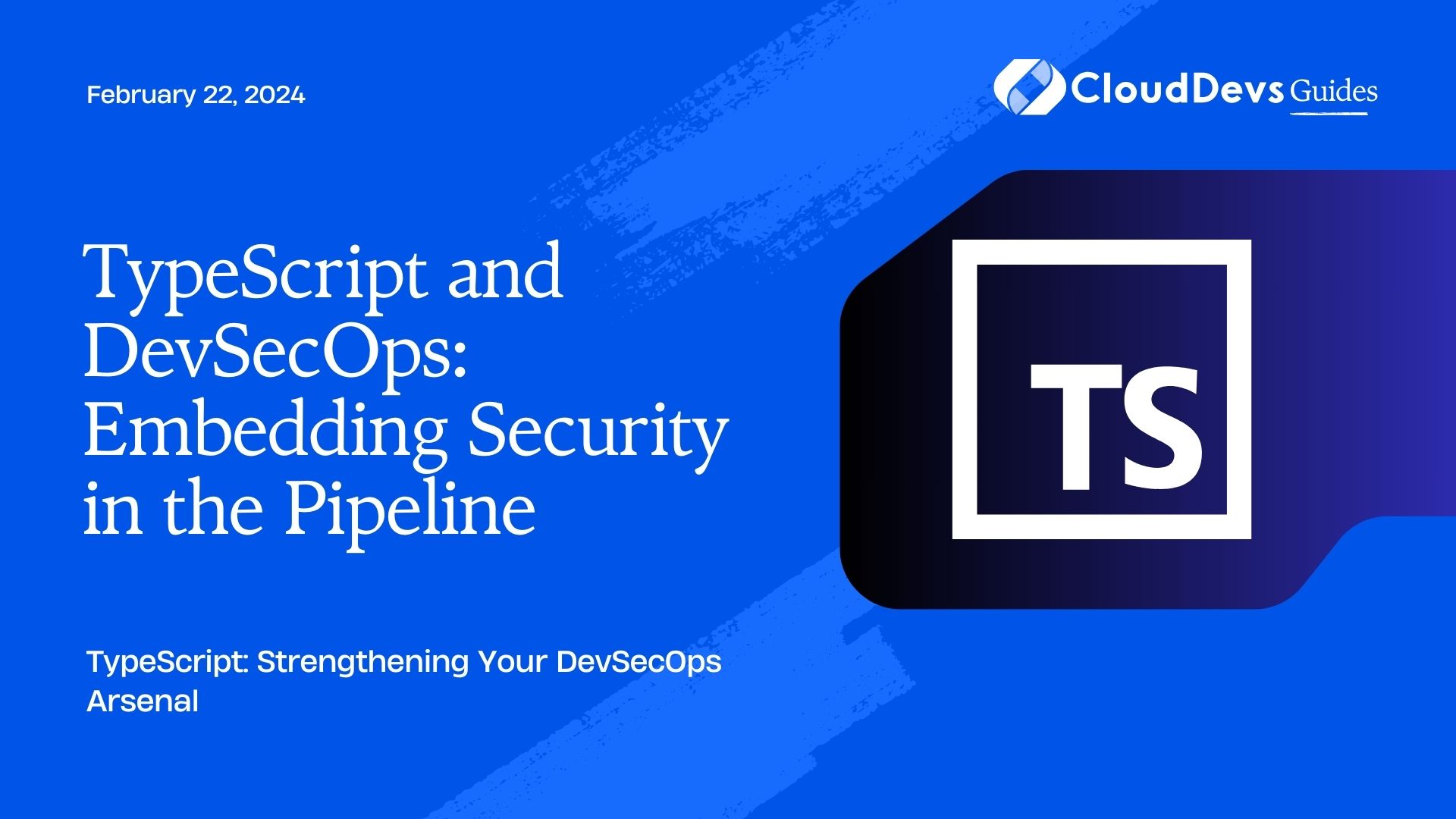TypeScript and DevSecOps: Embedding Security in the Pipeline
In today’s fast-paced software development landscape, security is not a luxury; it’s a necessity. The rise of DevSecOps has been a game-changer in this regard. DevSecOps integrates security practices into the DevOps pipeline, ensuring that security is a priority from the start. In this blog, we’ll delve into the world of TypeScript and DevSecOps, exploring how you can embed security into your pipeline using TypeScript. We’ll cover best practices, tools, and provide code samples to help you build a robust and secure development process.
Table of Contents
1. Understanding DevSecOps
1.1. What is DevSecOps?
DevSecOps is a philosophy and set of practices that prioritize security at every stage of the software development lifecycle (SDLC). It seeks to bridge the gap between development, security, and operations teams, ensuring that security is not an afterthought but an integral part of the process.
1.2. Why DevSecOps?
Traditional development practices often treat security as a separate phase, leading to vulnerabilities that are discovered late in the development cycle. DevSecOps aims to address this issue by:
- Shifting Left: Introducing security from the earliest stages of development.
- Automation: Automating security checks and testing.
- Collaboration: Promoting collaboration between development, security, and operations teams.
2. TypeScript: A Secure Choice
2.1. Why TypeScript?
TypeScript is a statically typed superset of JavaScript. It offers the benefits of strong typing, which can help catch potential security issues early in development. TypeScript provides:
- Type Safety: Helps prevent common runtime errors.
- Tooling: Rich tooling and IDE support for code analysis.
- Readability: Improved code readability and maintainability.
Using TypeScript in your DevSecOps pipeline can be a strategic choice to enhance security.
3. Embedding TypeScript in DevSecOps
Now that we understand the importance of both DevSecOps and TypeScript, let’s explore how to embed TypeScript in your DevSecOps pipeline effectively.
3.1. Code Analysis
3.1.1. Static Code Analysis
Static code analysis tools can scan your TypeScript code for known vulnerabilities and coding errors. Tools like ESLint and TSLint have plugins that specifically target TypeScript.
typescript
// Sample ESLint configuration for TypeScript
{
"parser": "@typescript-eslint/parser",
"plugins": ["@typescript-eslint"],
"rules": {
"@typescript-eslint/no-unused-vars": "error",
"@typescript-eslint/explicit-function-return-type": "error",
// Add more rules as needed
}
}
By configuring these tools to run as part of your CI/CD pipeline, you can catch potential security issues before they make their way into production.
3.1.2. Dependency Scanning
In addition to analyzing your TypeScript code, it’s crucial to scan your project’s dependencies for known vulnerabilities. Tools like OWASP Dependency-Check can help with this.
3.2. Unit Testing
Unit tests are essential in ensuring that your TypeScript code functions as intended. They also play a significant role in identifying security vulnerabilities. For example, you can write tests to check for input validation and proper handling of sensitive data.
typescript
// Sample unit test for input validation
test("Input validation should reject invalid input", () => {
const result = validateInput("invalid input");
expect(result).toBe(false);
});
3.3. Integration Testing
Integration tests help ensure that different components of your application work together securely. You can use tools like Jest or Cypress for TypeScript-based integration testing.
typescript
// Sample Cypress test for authentication flow
it("should successfully log in", () => {
cy.visit("/login");
cy.get('input[name="username"]').type("yourUsername");
cy.get('input[name="password"]').type("yourPassword");
cy.get('button[type="submit"]').click();
cy.url().should("eq", "https://yourapp.com/dashboard");
});
3.4. Continuous Monitoring
Continuous monitoring is an integral part of DevSecOps. Implement tools like security information and event management (SIEM) systems to monitor your application in real-time. TypeScript can facilitate logging and monitoring by providing structured and typed logs.
typescript
// Sample TypeScript code for structured logging
import { Logger } from "logger-library";
const logger = new Logger();
function processOrder(order: Order) {
try {
// Process the order
// ...
logger.info("Order processed successfully", { orderId: order.id });
} catch (error) {
logger.error("Error processing order", { orderId: order.id, error: error.message });
}
}
3.5. Security Champions
Designate security champions within your development teams. These individuals should have expertise in security and take the lead in identifying and addressing security issues. TypeScript can assist by providing type annotations that document security-related decisions and constraints.
4. DevSecOps Tools for TypeScript
To effectively embed TypeScript into your DevSecOps pipeline, you’ll need the right set of tools. Here are some popular tools that can enhance your security practices:
4.1. Snyk
Snyk is a widely-used security platform that helps you find, fix, and prevent known vulnerabilities in your TypeScript code and dependencies. It integrates seamlessly with popular CI/CD platforms.
4.2. OWASP Dependency-Check
OWASP Dependency-Check is a tool that identifies project dependencies and checks if there are any known, publicly disclosed, or exploitable vulnerabilities.
4.3. OWASP ZAP
OWASP ZAP (Zed Attack Proxy) is a popular open-source security testing tool for finding vulnerabilities in web applications. It supports TypeScript projects.
4.4. ESLint and TSLint
ESLint and TSLint are linters for JavaScript and TypeScript, respectively. They can be configured to enforce coding standards and catch potential security issues.
4.5. Jest and Cypress
Jest and Cypress are testing frameworks that support TypeScript. They are valuable for unit and integration testing.
5. Best Practices for TypeScript and DevSecOps
To wrap things up, let’s summarize some best practices for effectively embedding TypeScript in your DevSecOps pipeline:
5.1. Start Early
Begin security practices from the very start of your project. Code reviews and threat modeling sessions should consider security implications.
5.2. Automate Everything
Automate security checks, tests, and scans to ensure consistency and timely feedback.
5.3. Educate and Train
Invest in security awareness and training for your development teams. Ensure everyone understands their role in maintaining security.
5.4. Continuously Monitor
Implement continuous monitoring and alerting to respond to security incidents in real-time.
5.5. Collaborate Across Teams
Foster collaboration between development, security, and operations teams. Break down silos to facilitate communication and knowledge sharing.
By following these best practices and leveraging TypeScript and DevSecOps tools, you can build a secure development pipeline that helps you deliver robust and reliable software.
Conclusion
Security is not a one-time effort; it’s an ongoing commitment. Incorporating TypeScript into your DevSecOps pipeline can significantly enhance your security posture. By implementing static code analysis, unit and integration testing, continuous monitoring, and security champions, you can catch and address security issues early in the development process.
Remember, security is a shared responsibility across teams, and collaboration is key. Together with the right tools and best practices, TypeScript and DevSecOps can help you build secure and resilient software in an ever-evolving threat landscape.
Table of Contents









